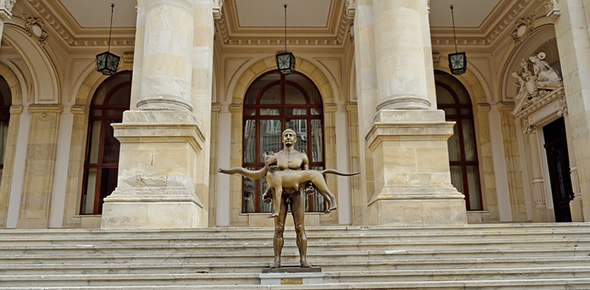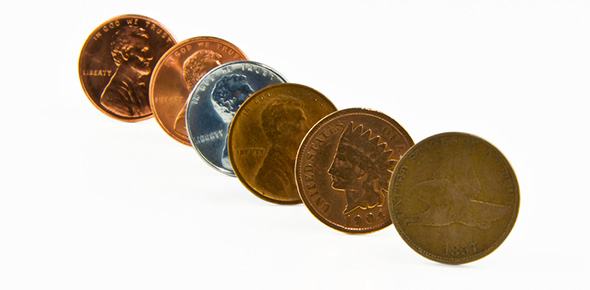Related Flashcards
Related Topics
Cards In This Set
| Front | Back |
|
What was the French Revolution?
|
The French Revolution (1789-1799) was a period of radical social and political upheaval in France as well as most of Europe. The absolute monarchy that had ruled France for centuries, collapsed within three years, It was more radical than either the English or American Revolutions, and had a far greater impact on 19th century Europe. The unthinkable fall of the Bourbons resonated throughout Europe, sparking a series of revolutions which rallied behind liberalism and nationalism. The major socialist revolutions of the twentieth century in Russia, China and Cuba were inspired the French example.
|
|
Explain Neoclassicism
|
Neoclassicism was a style of art the rose up during the 18th century in France. Polished, classical, and structural, the style contains themes of saturated red, blues, whites, and blacks, no outlines, classical layouts such as those that contain strong verticals and horizontals, and austere architectural backgrounds.
|
|
Explain Rococo
|
Rococo was a style of art that became popular during 18th century France. With themes of romance, fantasy, and mischievous eroticism, this lavish style favored the lives of the aristocracy as focus points, capturing the elegant ornamentation and frivolous obsession with beauty that the rich portray over all else.
|
|
Explain Enlightenment
|
The Enlightenment, also called the Age of Reason or the Age of Rationalism, was a period during the seventeenth and eighteenth centuries when European philosophers stressed the use of reason as the best method for learning the truth. Such philosophers as Jean-Jacques Rousseau (1712–1778) and Voltaire (1694–1778) in France and John Locke (1632–1704) in England pondered aspects of education, law, social theory, superstition, and ignorance. Hallmarks of the Enlightenment include the idea that the universe is systematic though vast and complex; the belief that men and women are capable of understanding the universe; and the philosophy of Deism. According to Deism, God created the world and natural laws, then withdrew from involvement in the workings of the universe.
|
|
Explain Romanticism
|
Romanticism was an artistic and intellectual movement originating in Europe in the late 18th century and characterized by a heightened interest in nature, emphasis on the individual's expression of emotion and imagination, departure from the attitudes and forms of classicism, and rebellion against established social rules and conventions.
|
|
Explain Orientalism
|
Orientalism is a art-historical term applied to a category of subject-mitter referring to the depiction of the Near East by Western artists, particularly in the 19th century.
Images of the life, history and topography of Turkey, Syria, Iraq, Iran, the Arabian Peninsula, Jordan, Israel, Lebanon, Egypt, Libya, Tunisia, Algeria, Morocco and sometimes modern Greece, the Crimea, Albania and the Sudan constitute the field of Orientalism. Although almost any biblical subject in Western art would rank as an Orientalist image by this definition, most such works dating before the 19th century fail to present any specifically Near Eastern details or atmosphere and are not Orientalist. Artists need not have journeyed to the Near East to be labelled Orientalist, but their works must have some suggestion of topographic or ethnographic accuracy. |
|
Explain Odalisque
|
The French term odalisque derives from the Turkish-Ottoman word odalik, which refers to a female slave owned by a Muslim male. The odalisque became a favorite theme of European artists in the eighteenth and nineteenth centuries as a symbol, in the European view, of Muslim sensuality and sexual practices.
|
|
Explain Colonialism
|
The 19th Century was an age of expansion and colonialism. In the 1800s, as Americans explored the west and settled across the North American continent, Victorian Britain stood astride much of the world, and other great powers consolidated colonial holdings in Africa and Asia.
|
|
Explain Nationalism
|
Our idea of Nationalism didn't exist until the 17th/18th Centuries. This is because the "nation" as a concept didn't really exist either. Certainly, people had strong attachments to where they lived but this didn't translate to patriotism - most people didn't travel very far and felt relatively little connection to those outside that bubble.
This is exemplified in the quote, attributed to Louis IV(probably incorrectly), "l'etat c'est moi" - I am the state. The state was simply the holdings of the monarch. Explorers claimed land for the crown, not the "nation". With the American/French Revolution(s), you get the first real evidence of "Nationalism" in two different contexts. The French then spread these ideas around Europe where they posed serious threats to the established order - the Austrian empire in particular was a multi-ethnic empire who subsequently struggled with various national movements(it was a Bosnian Serb who assassinated Archduke Ferdinand in 1914). |
|
Explain Reign of Terror
|
(1793 – 94)The Reign of Terror was a period in the French Revolution. It was established by the government on Sept. 5, 1793, to take harsh measures against those suspected of being enemies of the Revolution (including nobles, priests, and hoarders). Controlled by the radical Committee of Public Safety and Maximilien Robespierre, the Terror eliminated enemies on the left (Jacques Hébert and his followers) and the right (Georges Danton and the Indulgents). A law passed in June 1794 that suspended a suspect's right to public trial or legal defense caused the Thermidorian Reaction, and the Terror ended on July 27, 1794, with Robespierre's overthrow. About 300,000 suspects were arrested during the period; about 17,000 were executed, and many others died in prison.
|
|
Who was Diderot?
|
Denis Diderot is one of the towering figures of the 18th century Enlightenment period, thanks largely to his editorship of the Encylopédie, one of the great attempts to catalog human knowledge. A prolific writer and talented talker, Diderot moved away from his early Jesuit training to an atheistic materialism, and had a great influence on the intellectual and political development in pre-revolution France.
|
|
Explain Sublime
|
The sublime is the quality of greatness or vast magnitude, whether physical, moral, intellectual, metaphysical, aesthetic, spiritual or artistic. The term especially refers to a greatness with which nothing else can be compared and which is beyond all possibility of calculation, measurement or imitation.
|
|
Explain Nazarenes
|
Nazarene were some of the earliest names given to the followers of Jesus. In Acts 24:5 the lawyer Tertullus calls Paul "a ringleader of the sect of the Nazarenes", and Paul subsequently (Acts 24:14) connects the epithet to the more common name, "The Way". At that point, the "sect" was in fact a sect of Judaism, in the same way that Essenes, Sicarii and Pharisees were sects of Judaism. In later centuries several Church Fathers refer to the Nazarene sect, but by that time it was considered a sect of the church, a sect of Jewish Christians. These post-NT Nazarenes left Jerusalem shortly before it was destroyed in A.D. 70 and fled to the Decapolis city of Pella. After the war some returned to Jerusalem while others moved further north, into Coele Syria. They are reported to have maintained a Christology compatible with that of the Nicene church (unlike their offshoot cousins, the Ebionites).
|
|
Who was Napoleon?
|
Napoleon was the emperor of the French (1804-1814). A brilliant military strategist, he deposed the French Directory (1799) and proclaimed himself first consul and, later, emperor (1804). His military and political might gripped Continental Europe but failed to encompass Great Britain. After a disastrous winter campaign in Russia (1812), he was forced to abdicate (1814). Having been exiled to the island of Elba, he escaped, briefly regained power, and was ultimately defeated at Waterloo (1815) and exiled for life to the island of St. Helena. His codification of laws, the Napoleonic Code, still forms the basis of French civil law.
|
|
Explain Ossian
|
Ossian was a legendary hero and poet and son of Finn, who is supposed tohave lived during the 3rd century a.d., represented ingaelic poems and in imitations of them written by JamesMacpherson in the 18th century.
|





